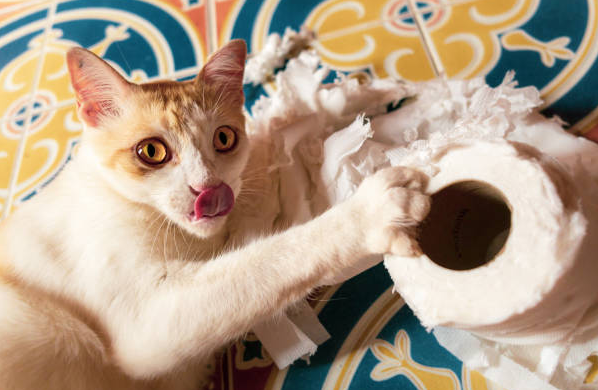
From myself! As cat owners, one of our top priorities is ensuring that our feline friends are happy, healthy, and safe in their home environment. Cats are naturally curious creatures, and while their independence is part of their charm, it can also lead to dangerous situations if they’re not properly supervised or if their environment isn’t cat-proofed. Whether your cat is a kitten exploring the world or a senior cat looking for a safe and comfortable space, there are several ways to ensure they stay out of harm’s way.
Cat Proofing
Cats have an uncanny ability to get into places we never expect. From knocking over vases to chewing on electrical cords, curiosity could harm your cat. Cat-proofing your home is the first step in keeping them safe.
- Secure Hazardous Items: Tie up loose cords, such as electrical cables and blind cords, to prevent your cat from chewing on them or getting entangled. Consider investing in protective coverings for cords if needed.
- Hide Toxic Substances: Cats love to chew on things, and some household items can be dangerous if ingested. Make sure to keep toxic plants (like lilies and poinsettias), chemicals (cleaning products, pesticides, etc.), and human foods (chocolate, onions, grapes) out of reach.
- Close Off Small Spaces: Cats love squeezing into tiny places, but some of these spaces may not be safe. Keep closets, cabinets, and other tight spaces securely closed to prevent your cat from hiding in potentially dangerous areas.
Keep Their Environment Safe
A safe home isn’t just one that’s free of hazards—it should also be enriching and comfortable for your cat’s physical and mental well-being. Providing opportunities for play, exploration, and relaxation is crucial to ensuring your cat feels safe and content.
- Cat Furniture and Scratching Posts: Give your cat designated areas to climb, scratch, and lounge. Scratching posts, climbing towers, and cozy cat beds not only help your cat stay entertained but also provide them with a safe space to rest. Place these items in areas that are free from danger, like away from sharp objects or fragile decorations.
- Windows and Screens: Cats love to perch by windows, but open windows can pose a risk. Install window screens that are secure enough to prevent your cat from falling out if they jump or lean on them. Keep windows closed or partially open to ensure your cat stays safe while still enjoying the view.
Safe Spaces
Sometimes, your cat just needs a quiet, secure space to retreat to. Creating a designated safe zone—especially if your cat gets stressed by loud noises, new visitors, or other pets—will help them feel more secure.
- Safe Hideaway: Set up a quiet corner or a cozy bed where your cat can escape from the hustle and bustle of the household. This space should be free from distractions and dangers (like electrical cords or breakable items), giving your cat a place to recharge and feel at ease.
- Cat-Proofed Room: If you need to confine your cat to a specific area of your home, make sure the room is cat-proofed. Remove any harmful objects, keep all chemicals and food out of reach, and make sure windows and doors are secure.
Supervise New Interactions
While socializing your cat is important, you should always supervise their interactions with other pets and people to ensure their safety. Not all cats are comfortable around new people or animals, and some can become stressed or aggressive if they feel threatened.
- Introducing New Pets: When introducing a new pet, such as a dog or another cat, do so slowly and carefully. Make sure both animals have their own space, and allow them to get used to each other’s scent before face-to-face interactions. Gradually increase the time they spend together to prevent stress or conflict.
- Monitor Play with Children: Children may unintentionally hurt your cat by being too rough. Teach children how to approach and handle cats gently, and supervise their playtime to prevent accidental injuries.
Vet Visits and Grooming
Keeping your cat healthy is essential to their safety. Regular vet check-ups ensure that any potential health issues are caught early, and grooming helps prevent problems like matting, skin infections, or hairballs. By staying on top of your cat’s health, you can prevent many safety risks before they become a serious issue.
- Vet Visits: Schedule regular vet visits to ensure your cat is up-to-date on vaccinations, flea treatments, and overall health checks. Your vet can also recommend preventive measures for certain conditions, like arthritis or dental disease, which can affect your cat’s comfort and mobility.
- Grooming: Regular grooming is especially important for long-haired cats, but even short-haired cats benefit from occasional brushing. This helps prevent hairballs and matting, which can be uncomfortable or even harmful to your cat. It’s also a good opportunity to check for fleas or skin conditions. And let’s not forget nail trimming – whether you do it yourself or take them to your Vet’s office to have it done.
Use Of Safe Pet Deterrents
If there are areas in your home that are especially dangerous (like the kitchen, laundry room, or areas with sharp objects), consider using cat-safe deterrents to prevent your cat from exploring those places. You can use safe sprays or motion detectors that make noise to discourage them from going into restricted areas.
Keeping your cat safe in their home environment is all about being proactive and mindful of their curious nature. By cat-proofing your home, providing enriching spaces, and ensuring their health and well-being, you can create a secure environment where your cat can thrive. With the right precautions and a little extra care, you can rest easy knowing that Fluffy is in a safe and comfortable place.
Ciao,








